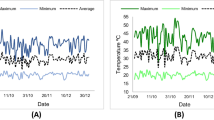Abstract
The effect of previous infestation by the cotton aphid (Aphis gossypii Glover) on resistance of cotton seedlings to further infestation by the same insect, was examined in the laboratory. Seedlings which survived a heavy infestation and produced new leaves, were recolonized artificially and the fate of the colonizers was monitored. The two cotton varieties used in the experiments differed in resistance to aphid colonization, and a few seedlings were initially unsuitable for aphid colonization. Aphids transferred to new leaves on previously infested plants were not so successful as on uninfested seedlings and repeated attempts over a few weeks were sometimes required until a colony became established. Reinfested plants often showed no visible signs of stress, but the aphid colonies were frequently of the ‘yellow dwarf’ morph, indicating that the plants had been stressed after the first infestation. We suggest that damage caused by the first infestation — and not the production of some excess metabolites — is the reason for the lower success on previously infested plants.
Similar content being viewed by others
References
Blackman, R.L. and Eastop, V.F. (1984) Aphids in the World’s Crops. Wiley, Chichester, UK.
Brody, A.K. and Karban R. (1989) Demographic analysis of induced resistance against spider mites (Acari: Tetranychidae) in cotton.J. Econ. Entomol. 82: 462–465.
Girousse, C. and Bournoville, R. (1994) Role of phloem sap quality and exudation characteristics on performance of pea aphid grown on lucerne genotypes.Entomol. Exp. Appl. 70: 227–235.
Grafton-Cardwell, E.E. (1991) Geographical and temporal variation in response to insecticides in various lifestages ofAphis gossypii (Homoptera: Aphididae) infesting cotton in California.J. Econ. Entomol. 84: 741–749.
Hardee, D.D. and Ainsworth, J.M. (1993) Cotton aphid (Homoptera: Aphididae): effects of infurrow insecticides on pesticide resistance.J. Econ. Entomol. 86: 1026–1029.
Harrison, S. and Karban, R. (1986) Behavioral responses of spider mites (Tetranychus urticae) to induced-resistance of cotton plants.Ecol. Entomol. 11:181–188.
Jones, C.G., Hopper, R.F., Coleman, J.S. and Krischik, V.A. (1993) Control of systemically induced herbivore resistance by plant vascular architecture.Oecologia 93:452–456.
Karban, R. (1988) Resistance to beet armyworm (Spodoptera exigua) induced by exposure to spider mites (Tetranychus turkestani) in cotton.Am. Midl. Nat. 119:77–82.
Karban, R. (1993) Induced resistance and plant density of a native shrub,Gossypium thurberi, affects its herbivores.Ecology 74:1–8.
Karban, R. (1993) Costs and benefits of induced resistance and plant density for a native shrub,Gossypium thurberi.Ecology 74:9–19.
Karban, R. and Carey, J.R. (1984) Induced resistance of cotton seedlings to mites.Science 225:53–54.
Karban, R. and English-Loeb, G.M. (1990) A “vaccination” of Willamette spider mite (Acari: Tetranychidae) to prevent large populations of Pacific spider mite on grapevines.J. Econ. Entomol. 83:2252–2257.
Karban, R. and Myers, J.H. (1989) Induced plant resistance to herbivory.Annu. Rev. Ecol. Syst. 20:331–348.
Karban, R. and Niiho, C. (1995) Induced resistance and susceptibility to herbivory: plant memory and altered plant development.Ecology 76:1220–1225.
Kerns, D.L. and Gaylor, M.J. (1992) Insecticide resistance in field populations of the cotton aphid (Homoptera, Aphididae).J. Econ. Entomol. 85:1–8.
Kranz, J., Schmutterer, H. and Koch, W. (1977) Diseases, Pests and Weeds in Tropical Crops. Paul Parey Verlag, Berlin.
Liu Xuming (1989) Studies on the resistance of cotton varieties to the cotton aphid (Aphis gossypii Glover) and the mechanism of resistance.Proc. 19th Int. Congr. Entomology (Beijing, China) (English abstract).
Liu Xuming and Yang Quihua (1990) Biochemical bases of resistance to cotton aphid in some non-gossypol cotton varieties. pp. 296–299, 484-485.in: Chen, Q.Y., Li, D.M. and Cao, C.Y. [Eds.], Advances in IPM on Cotton. China Agricultural Science Press, Beijing (Chinese, with English summary).
Liu Xuming and Yang Quihua (1991) The role of proline in varietal resistance of cotton toAphis gossypii.Acta Agric. Univ. Pekinensis 17:77–80 (Chinese, with English summary)
Öquist, G. and Wass, R. (1988) A portable, microprocessor-operated instrument for measuring chlorophyll fluorescence kinetics in stress physiology.Physiol. Plant. 73:211–217.
Quiring, D., Turgeon, J., Simpson, D. and Smith, A. (1991) Genetically-based susceptibility of white spruce to the spruce bud worm.Can. J. For. Res. 21:42–47.
Rohlf, F.J. (1987) BIOM, A Package of Statistical Programs. Exeter Software, New York, NY.
Saito, T. (1989) Insecticide resistance of the cotton aphidAphis gossypii Glover (Homoptera, Aphididae). I. Susceptibility to several insecticides and esterase activity of field populations collected in Shiznoka prefecture.Jpn. J. Appl. Entomol. Zool. 33:204–210 (Japanese, with English summary).
Sokal, R.R. and Rohlf, F.J. (1981) Biometry. 2nd ed. Freeman, San Francisco, CA, USA.
Weathersbee, A.A. and Hardee, D.D. (1994) Abundance of cotton aphids (Homoptera, Aphididae) and associated biological control agents on six cotton cultivars.J. Econ. Entomol. 87:258–265.
Weathersbee, A.A., Hardee, D.D. and Meredith, W.R. (1994) Effects of cotton genotype on seasonal abundance of cotton aphid (Homoptera: Aphididae).J. Agric. Entomol. 11:29–37.
Wellings, P.W. and Dixon, A.F.G. (1987) Sycamore aphid numbers and population density. III. The role of aphid-induced changes in plant quality.J. Anim. Ecol. 56:161–170.
Wilhoit, L.R. and Rosenheim, J.A. (1993) The yellow dwarf form of the cotton aphid,Aphis gossypii. Proc. Beltwide Cotton Conf. (Memphis, TN, USA), pp. 969-972.
Wool, D., Hales, D. and Sunnucks, P. (1995) Host plant relationships ofAphis gossypii Glover (Homoptera: Aphididae) in Australia.J. Aust. Entomol. Soc. 34:265–271.
Author information
Authors and Affiliations
Corresponding author
Rights and permissions
About this article
Cite this article
Wool, D., Hales, D.F. Previous infestation affects recolonization of cotton byAphis gossypii: induced resistance or plant damage?. Phytoparasitica 24, 39–48 (1996). https://doi.org/10.1007/BF02981452
Received:
Issue Date:
DOI: https://doi.org/10.1007/BF02981452




